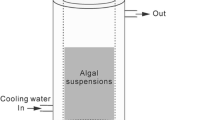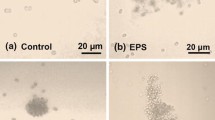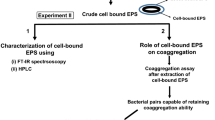Abstract
The red-tide dinoflagellate Protoceratium reticulatum is shown to be protected against turbulence-associated damage by the use of the additives Pluronic F68 (PF68) and carboxymethyl cellulose (CMC) in the culture medium. Relative to agitated controls, these additives had a dose-dependent protective effect at concentrations of up to 0.4 and 0.5 g L−1 for CMC and F68, respectively. In static cultures, these additives inhibited growth directly or indirectly at a concentration of >0.5 g L−1. Compared to CMC, PF68 was a better protectant overall. Cell-specific production of yessotoxins was enhanced under elevated shear stress regimens so long as the turbulence intensity was insufficient to damage the cells outright. Shear-induced production of reactive oxygen species and direct effects of turbulence on the cell cycle contributed to the observed shear effects.









Similar content being viewed by others
Abbreviations
- CMC:
-
Carboxymethyl cellulose
- d p :
-
Diameter of the cells (m)
- d s :
-
Diameter of the shake flask (m)
- n :
-
Rotational speed of the shake flask (s−1)
- PF68:
-
Pluronic F68
- ROS:
-
Reactive oxygen species
- t c :
-
Total cycle time (s)
- t s :
-
Duration of the quiescent period within one agitation cycle (s)
- t t :
-
Duration of turbulence within one agitation cycle (s)
- V L :
-
Volume of the broth in the flask (m3)
- YTX:
-
Yessotoxin
- γ ar :
-
Reference value of average shear rate calculated using d p = 20.5 μm and seawater viscosity (s−1)
- γ av :
-
Average shear rate (s−1)
- γ t :
-
Applied shear rate (s−1)
- μ L :
-
Viscosity of the broth (Pa s)
- μ r :
-
Ratio of the maximum specific growth rates of the agitated culture and the corresponding static control
- μ ra :
-
Ratio of the maximum specific growth rate in an agitated culture with protective additive and the maximum specific growth rate in an identically agitated culture but without the additive
- ν :
-
Cycle frequency (= 1/t c) (s−1)
- ρ L :
-
Density of the broth (kg m−3)
- τ ar :
-
Reference value of average shear stress calculated using d p = 20.5 μm (Pa) and seawater viscosity (s−1)
- τ av :
-
Average shear stress (Pa)
- τ t :
-
Applied shear stress (Pa)
- ϕ :
-
Fraction of the time shaken in one agitation cycle
References
Wang DZ (2008) Neurotoxins from marine dinoflagellates: a brief review. Mar Drugs 6:349–371
García Camacho F, Gallardo Rodríguez JJ, Sánchez Mirón A, Cerón García M, Belarbi EH, Chisti Y, Molina Grima E (2007) Biotechnological significance of toxic marine dinoflagellates. Biotech Adv 25:176–194
Paz B, Daranás AH, Norte M, Riobó P, Franco J, Fernández JJ (2008) Yessotoxins, a group of marine polyether toxins: an overview. Mar Drugs 6:73–102
Watkins SM, Reich A, Fleming LE, Hammond R (2008) Neurotoxic shellfish poisoning. Mar Drugs 6:431–455
Wong JTY, Kwok ACM (2005) Proliferation of dinoflagellates: blooming or bleaching. BioEssays 27:730–740
Berdalet E (1992) Effects of turbulence on the marine dinoflagellate Gymnodinium nelsonii. J Phycol 28:267–272
Juhl AR, Latz MI (2002) Mechanisms of fluid shear-induced inhibition of population growth in a red-tide dinoflagellate. J Phycol 38:683–694
Juhl AR, Velázquez V, Latz MI (2000) Effect of growth conditions on flow-induced inhibition of population growth of a red-tide dinoflagellate. Limnol Oceanogr 45:905–915
Pollingher U, Zemel E (1981) In situ and experimental-evidence of the influence of turbulence on cell-division processes of Peridinium cinctum Forma Westii (Lemm) Lefevre. Br Phycol J 16:281–287
Yeung PKK, Wong JTY (2003) Inhibition of cell proliferation by mechanical agitation involves transient cell cycle arrest at G1 phase in dinoflagellates. Protoplasma 220:173–178
García Camacho F, Gallardo Rodríguez JJ, Sánchez Mirón A, Cerón García M, Belarbi EH, Molina Grima E (2007) Determination of shear stress thresholds in toxic dinoflagellates cultured in shaken flasks. Implications in bioprocess engineering. Process Biochem 42:1506–1515
Yeung PKK, Lam CMC, Ma ZY, Wong YH, Wong JTY (2006) Involvement of calcium mobilization from caffeine-sensitive stores in mechanically induced cell cycle arrest in the dinoflagellate Crypthecodinium cohnii. Cell Calcium 39:259–274
Gallardo Rodríguez JJ, Sánchez Mirón A, García Camacho F, Cerón García M, Belarbi EH, Chisti Y, Molina Grima E (2010) Culture of dinoflagellates in a fed-batch and continuous stirred-tank photobioreactors: growth, oxidative stress and toxin production. Process Biochem 45:660–666
Mallipattu SK, Haidekker MA, Von Dassow P, Latz MI, Frangos JA (2002) Evidence for shear-induced increase in membrane fluidity in the dinoflagellate Lingulodinium polyedrum. J Com Physiol A Neuroethol Sens Neural Behav Physiol 188:409–416
Al-Rubeai M, Emery AN, Chalder S (1992) The effect of Pluronic F-68 on hybridoma cells in continuous culture. Appl Microbiol Biotechnol 37:44–45
Chisti Y (1999) Shear sensitivity. In: Flickinger MC, Drew SW (eds) Encyclopedia of bioprocess technology: fermentation, biocatalysis, and bioseparation, vol 5. Wiley, New York
Chisti Y (2001) Hydrodynamic damage to animal cells. Crc Crit Rev Biotechnol 21:67–110
García Camacho F, Molina Grima E, Sánchez Mirón A, González Pascual V, Chisti Y (2001) Carboxymethyl cellulose protects algal cells against hydrodynamic stress. Enzyme Microb Tech 29:602–610
Sánchez Mirón A, Cerón García M, Contreras Gómez A, García Camacho F, Molina Grima E, Chisti Y (2003) Shear stress tolerance and biochemical characterization of Phaeodactylum tricornutum in quasi steady-state continuous culture in outdoor photobioreactors. Biochem Eng J 16:287–297
Gallardo Rodríguez JJ, Cerón García M, García Camacho F, Sánchez Mirón A, Belarbi EH, Molina Grima E (2007) New culture approaches for yessotoxin production from the dinoflagellate Protoceratium reticulatum. Biotechnol Progr 23:339–350
Díaz J, Serrano E, Acosta F, Carbonell L (1998) Lipoperoxides kit evaluated for measuring lipoperoxides in biological samples: reference intervals for human plasma. Clin Biochem 31:277–279
Paz B, Riobó P, Fraga S, Franco JM, Fernández ML (2004) Production and release of yessotoxins by the dinoflagellates Protoceratium reticulatum and Lingulodinium polyedrum in culture. Toxicon 44:251–258
Molina Grima E, Acién Fernández FG, García Camacho F, Camacho Rubio F, Chisti Y (2000) Scale-up of tubular photobioreactors. J Appl Phycol 12:355–368
Gallardo Rodríguez JJ, Sánchez Mirón A, García Camacho F, Cerón García M, Belarbi EH, Chisti Y, Molina Grima E (2009) Causes of shear sensitivity of the toxic dinoflagellate Protoceratium reticulatum. Biotechnol Progr 25:792–800
Chisti Y (2000) Animal-cell damage in sparged bioreactors. Trends Biotechnol 18:420–432
Vardi A, Berman-Frank I, Rozenberg T, Hadas O, Kaplan A, Levine A (1999) Programmed cell death of the dinoflagellate Peridinium gatunense is mediated by CO2 limitation and oxidative stress. Curr Biol 9:1061–1064
Juhl AR, Trainer VL, Latz MI (2001) Effect of fluid shear and irradiance on population growth and cellular toxin content of the dinoflagellate Alexandrium fundyense. Limnol Oceanogr 46:758–764
Acknowledgments
This research was supported by the Spanish Ministry of Education and Science (AGL2005-07924-C04-04) and the Spanish Ministry of Science and Innovation (CTQ2008-06754-C04-02/PPQ).
Author information
Authors and Affiliations
Corresponding author
Rights and permissions
About this article
Cite this article
Gallardo Rodríguez, J.J., Sánchez Mirón, A., García Camacho, F. et al. Carboxymethyl cellulose and Pluronic F68 protect the dinoflagellate Protoceratium reticulatum against shear-associated damage. Bioprocess Biosyst Eng 34, 3–12 (2011). https://doi.org/10.1007/s00449-010-0441-7
Received:
Accepted:
Published:
Issue Date:
DOI: https://doi.org/10.1007/s00449-010-0441-7




